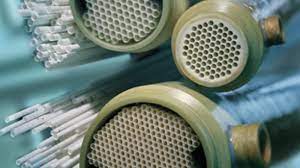Membrane Technologies
Membrane Technologies have several membrane configurations available for Membrane Bioreactor (MBR) applications. Project requirements should drive the decision for membrane selection.
Technologies available for use in MBRs:
- Tubular
- Hollow Fiber
- Flat Sheet
Tubular Membranes
The original and most proven type of ultrafiltration is tubular membranes:
- Sturdy construction
- Long membrane life
- High flux rates
Of all membrane types, they are more robust and can be subjected to high pressures in demanding applications.
Out-of-Basin MBR is a configuration where mixed liquor is pumped at high velocity through the tubular membrane module. The high velocity continuously scours the membrane surface and prevents solids from building up. This process produces high flux rates and simple operation. No backwash is required. Lowest capital cost option because of the high flux rates and simple operation. Out-of-Basin MBRs by Dynatec are designed so that the energy requirements are equal to other types of MBR systems.
Advantages
- Higher performance due to higher MLSS and long sludge age
- Low Cost
- Simple Operation
- Entire system may be placed indoors
- Membrane tank not required
Hollow Fiber Membranes
They are constructed of a microporous structure having a dense selective layer on the outside surface. Many fibers must be packed into bundles and potted into tubes to form a membrane module. The surface area of even a few square feet require miles of fibers. Modules must contain no defective or broken fibers, therefore production requires strict quality control.
These membranes can withstand very high pressures from the outside, but are limited on pressure exerted from the inside of the fiber, therefore backwash rates are limited to around twice the normal permeate rate. The feed fluid is applied on the outside of the fibers and the permeate is removed down the fiber bore.
Hollow Fiber membranes are applied in clean water applications and are used in MBRs, but are limited to lower concentrations of solids than the other membrane types.
Advantages
- Low Energy
- Membrane Space efficient for large installations >5 MGD (million gallons per day)
- Cost effective for large installations
Disadvantages
- Not Cost Effective for small plants
- Membranes damaged easily
- More complicated system
- Cannot operate with high MLSS
Flat Plate Membranes
They are constructed of a paper like backing material with a membrane cast on the surface of the paper. The membrane sheet is ultrasonically welded to both sides of a plastic plate. These plates are assembled into a submerged membrane unit and spaced about 1/4″ apart. The permeate passes through the membrane unit from the outside in. Course bubble air is sparged between the plates to prevent solids from building up on the plates and dewatering the membranes.
These membranes used in MBR applications require a biofilm to be attached to the membrane. The membrane is a support structure to the biofilm which actually provides the filtration. Care must be taken to maintain the biofilm on the membranes to prevent failure.
Advantages
- Can be low Energy
- Cost effective for medium installations 0.5-5 MGD
Disadvantages
- Not Cost Effective for small plants
- Cannot be backwashed
- Damaged easily
- Cannot operate with low MLSS
Membrane Technologies
Parameter |
Tubular HiRate™ |
Tubular Dynalift™ |
Hollow Fiber |
Flat Plate |
|---|---|---|---|---|
Estimated Life |
10+ years |
10+ years |
5-7 years |
10+ years |
MLSS Range |
≤20,000 mg/L |
1,000 – 20,000 mg/L |
≤8,000 mg/L |
8,000 – 18,000 mg/L |
Flux |
50-100 gfd |
20-30 gfd |
5-8 gfd |
8-20 gfd |
Backwash |
Not Required |
10Q |
2Q |
Membrane Damaged if backwashed |
Configuration |
Skid Mounted |
Skid Mounted |
Membrane Tank |
Membrane Tank |
System Energy |
4-6 KWhrs /M3 |
0.4 Kwhrs / M3 |
.4 Kwhrs / M3 |
0.4 Kwhrs / M3 |
TMP |
10-50 psig |
1-3 psig |
7-10 psig |
1-3 psig |
Conclusion
There are several membrane configurations available for MBR applications.
- Tubular membranes offer cost effective, reliable systems for small plants due to easy installation and small footprint.
- Flat plate and hollow fiber membranes must be placed into a tank and serviced with cranes. Therefore, the installed costs of these systems are much higher than tubular systems for small plants.
- Tubular system installations are typically completely installed in a building without concrete tanks.
- Requirements of the project should drive the decision for membrane supplier.
For more information and to learn which membrane technology is right for your application, please contact us today.
https://www.dynatecsystems.com/technologies/membrane-technologies/ultrafiltration-systems/
